Mobile Web or Mobile App?
Mục Lục
- What is mobile web?
- What is mobile app?
- Mobile web or mobile app?
- Mobile app takes up most of the using time, but …
- Top 5 mobile apps are almost exclusively dominating
- The number of download decreases, the rate of dropping app increases
- The cost for users to download the app is increasing
- Mobile web is still very important
- Mobile web is the mouth of the hopper and mobile app is the bottom of the hopper
- New solutions are emerging
“Mobile first” is a phrase that people working in the marketing field must hear a lot recently. It emphasizes that today’s mobile devices are the means most users use to access the internet most, and therefore businesses and companies need to think about how their products, services or content that are being communicated to customers must be optimized first for the mobile experience.
Now, there are mainly two ways to convey your content to mobile users, which are through the mobile web and through mobile app. Let’s get to know what they are, each way’s strengths as well as weaknesses and solutions to solve them.
What is mobile web?
Mobile websites are optimized to better display for users when they view the sites on phone. There are three common types of mobile web:
1. Responsive site
The website automatically resizes and changes its display method depending on the screen size of the device the user is using to access. All responsive website changes are usually CSS-based, with no impact on the HTML and the URL of the website remains unchanged.
Conversion.com is an example of a responsive site, displaying the same content and HTML whether on mobile or phone.
2. Dynamic serving site
The website automatically offers two different versions of the website based on the device by which the user visits the website. The difference between dynamic serving versus responsive is that the HTML that each device receives will be different. But the similarity is that the URL of the website will not change.
Google.com and Amazon.com are among the prominent examples of dynamic serving website?
3. Separated mobile site
Which also means to build two separate websites respectively for desktop and mobile. These websites’ content will not depend on the other’s, the URL is also different. These pages will often find which device the users is using to redirect them to the appropriate website version.
Facebook is an example of a website with a desktop page (facebook.com) and a mobile version (m.facebook.com) that are two separate pages.
Each type of mobile website has its own characteristics as well as strengths and weaknesses. Here is a statistic comparing the elements of each category:
| MOBILE WEB | |||
| Responsive | Dynamic Serving | Separate Mobile Site | |
| Description | Adjust to fit the screen size of the user device | Users will experience different web versions depending on the device | Different web versions for different using purpose |
| Settings | Only changes the CSS, HTML unchanged | Serve different HTML version depending on the device | 1 desktop version and 1 mobile version for the website |
| URL | Unchanged URL | Unchanged URL | Different URL for desktop and mobile |
| Maintenance | Not very costly on human resources | Costly on technical human resources | Costly on technical and content human resources |
| Content | Only 1 content for both desktop and mobile version | Only 1 content for both desktop and mobile version, or maybe different based on the development direction | 2 separated websites, the content maybe the same or different based on the development direction |
| Development costs | Low | Medium | High |
| User experience | Good for simple sites. Not advised for websites with many features and complexity. (with many complex features) | Good even for complex website with many features | Bringing the best experiences for mobile users |
| Impact on SEO | No impact | No impact | Need to be technically set up to avoid duplicate content |
| Web speed | The mobile version can load slower | Depending on the programming | Depending on the programming |
| Other issues | If the website is down, both desktop and mobile users can not access it | If the website is down, both desktop and mobile users can not access it | If the desktop website is down but not the mobile version then mobile users can still access it and vice versa |
In conclusion:
Responsive is very convenient and suitable for news sites, in which users only use it for reading the content. It has low setup cost, easy maintenance, fast and easy management of content, URL and SEO. This is the choice for most small and medium websites without complex features. For sites with more features requiring user interaction, responsive will sometimes not be enough to deliver the best user experience.
Dynamic serving is more complex and costly to set up technically but still easy to maintain, manage content, URLs and SEO. But dynamic serving provides a better user experience than responsive websites with features such as e-commerce.
The separate mobile site has the benefit of delivering the best mobile experience for mobile users as the entire website is designed and programmed to achieve that goal. However, the cost and time to implement is the most costly and the technical maintenance as well as content management, URL and SEO are also becoming more complex. If you have the cost, the time, and the desire to bring the best experience to your users, then this is the choice.
What is mobile app?
Mobile app is the applications that you can use to access the content you want on devices such as mobile phones. There are currently two types of apps you usually use and two more which are likely to be trending. Let’s take a look at these mobile app categories:
1. Native mobile app
This is the kind of app that you will download the content to your phone and access them when using. Kinds of apps that are representatives of this type include most of the games you usually play. Usually all of the images, sounds and levels in the game have been downloaded so you can play games without internet (some games require you to have internet to play simply because they requires logging in, buying items or because they are online games).
Facebook is a good example of a native mobile app.
2. Hybrid mobile app
Before talking about the hybrid mobile app, you need to understand the web app first. The web app is an application written on the browser platform so users can interact right there. The most common examples are web games, such as slither.io or some Facebook games that you are occasionally invited to play by your friends.
It is called hybrid (hybrid) mobile app because it combines the features of the web app and mobile app together. The hybrid mobile app is written in the web programming language (HTML5, CSS3 and Javascript) and is then “wrapped” with an external container to become like the native mobile app and can be downloaded on the appstore.
Some of the apps you regularly use are actually hybrid: Uber, Gmail Instagram, Evernote, Twitter, etc.
Native mobile app or hybrid mobile app, each has its strengths and weaknesses. Below is a comparison:
| MOBILE APP | |||
| Native Mobile App | Hybrid Mobile App | ||
| Description | Application installed on mobile devices | Website developed to be displayed on mobile as a mobile application | |
| Settings | Mobile application developed for each operating system | Only the container need developing, the content is from the website | |
| Development and maintenance cost | Very costly | Less costly | |
| Content Updating | Content updated by application upgrade version | Depending on the website | |
| User Experience | Very good as it is developed for the good cause of mobile user experience | Good but in some cases not as good as the native app | |
| Speed | Depending on how the the application is written | Depending on the internet speed | |
| Usability | Can be used even without network | Can not be used without network | |
| Application ize | Depending on the application programming, however, some native apps like games tend to be heavier due to having to download the entire contents | Depending on the application programming but in general, hybrid apps usually have smaller size as only necessary parts and contents from the website need to be downloaded | |
In conclusion:
Native mobile app: Delivering the best experience for the user, but also the most costly regarding the expense, time spent on application development as well as maintenance. Upgrading the content is not easy, as it is imperative to upgrade the whole application as well. Native applications can work even without a network if all necessary files have been downloaded to the device.
Hybrid mobile app: A good mobile user experience, developing applications is not simple but less complex than native mobile app. Updating content is easier because the content is synced from the website.
Mobile web or mobile app?
Mobile app takes up most of the using time, but …
The latest study by Flurry Analytics shows that 90% of the time people use the phone is interacting with the mobile app, only 10% use the browser to access the internet.
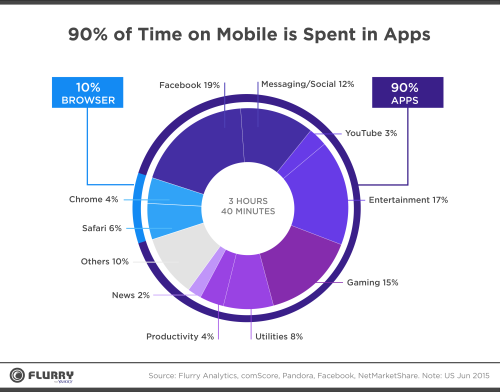
90% of the users’ time on the phone is using the app, only 10% is the browser. Source: Analytics Flurry
Does this mean that if you want to reach mobile users, you must definitely have a mobile app for your company? And mobile application is the best content transmission channel? The answer is, not really. Why?
Top 5 mobile apps are almost exclusively dominating
If you look at how you’re using mobile apps, you can see that most of the time when using a mobile app everyday, you just focus on a few essential apps (Facebook, Youtube, email, chat apps, etc …).
The comScore study actually found that the top five applications accounted for 80% to 90% of the total usage time on the mobile.
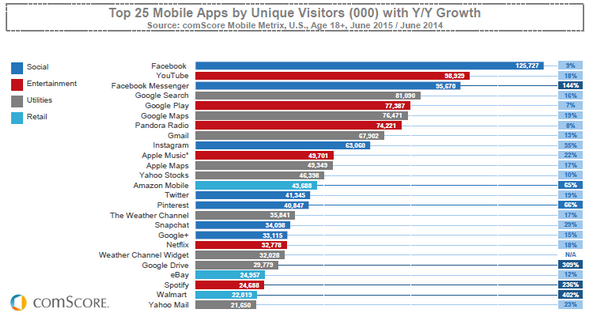
The majority of users only use 5 main apps – Source: comScore
This shows that unless you can get your application to the top, the likelihood of getting your app’s interaction will be very low or almost nonexistent.
The number of download decreases, the rate of dropping app increases
The number of mobile apps created and posted on the app store has been steadily increasing over the years:
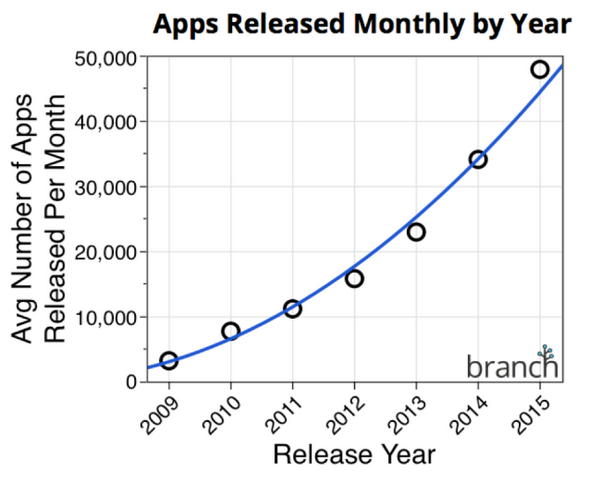
The number of apps submitted on the appstore is increasing. Source: Branch.io
But a recent study from Quartz and comScore also found that more than 65% of users do not download new applications to the phone every month.
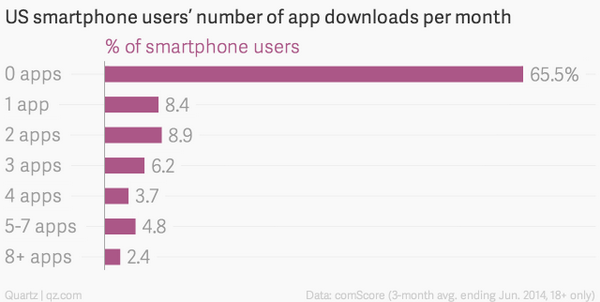
More than 65% of users do not download new applications every month. Source: Quartz
And the time users use the app before dropping it is also constantly decreasing:
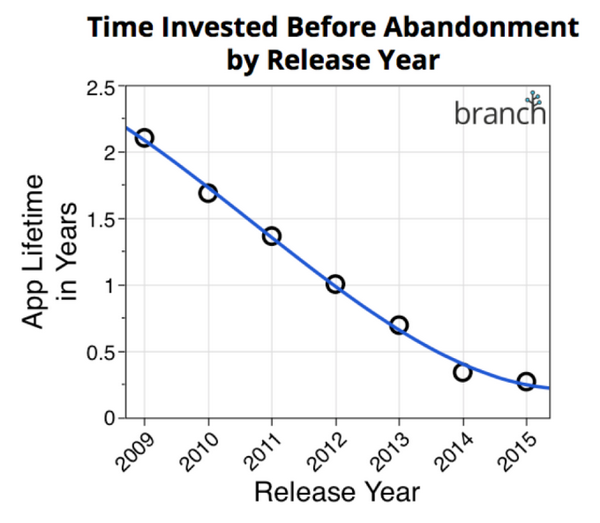
The time users use an app before dropping it is descending. Source: Branch.io
This shows that today’s application ecosystem is becoming increasingly competitive with too many applications, making new and smaller apps nearly impossible to be found and download by the user. And even though these apps are downloaded, the chances of being dropped from one or several times are very high.
The cost for users to download the app is increasing
For your app to be discovered and downloaded more, there are currently only two ways: topping the list on the app store or advertising on online channels to reach more people. And advertising the app is very important because the amount of download and use of the app is one of the factors determining whether the application could reach the top or not. But over time, the cost of advertising for app installs is increasing rapidly, growing by nearly 200% in just 12 months, according to Fiksu.
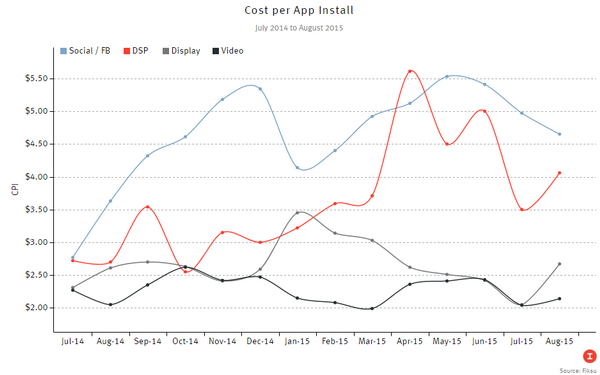
Cost per install has skyrocketed in just 12 months. Source: Fiksu
With the escalation in cost per install, investing to increase the number of users through advertising is nearly impossible for any app without financial capability. And even if someone downloads it, the possibility to give up the app is still very high, making it difficult to get the desired ROI from the app.
With all of these factors, we can see that the biggest difficulty of the application is how to engage the user in this saturated condition, and once you have the users, keeping them going is also a big challenge no less.
Mobile web is still very important
As mentioned above, only about 10% of the time in which users spend for mobile web, however, according to various sources, mobile web is considered to bring more traffic than the mobile app. Actually the connection between desktop web and mobile web is more convenient. Depending on the age of the user or category, sometimes the mobile web can reach more users:
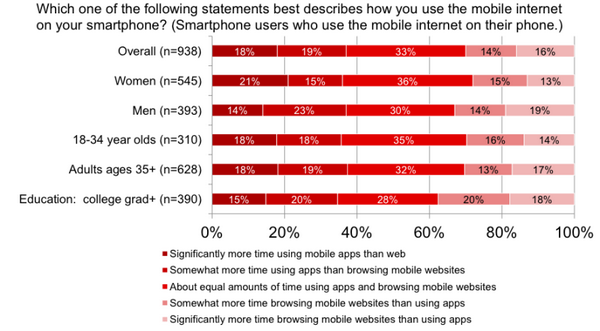
Usage of mobile app or mobile web depending on the age – Source: IAB
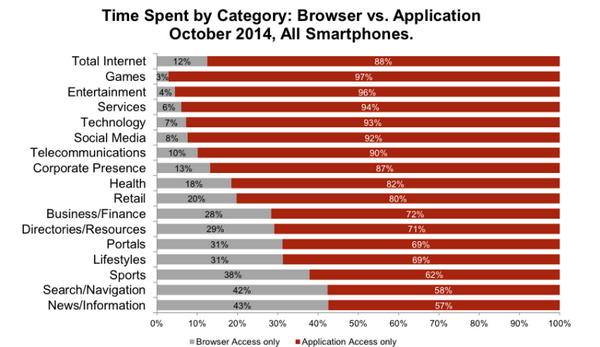
Mobile or mobile web usage by industry – Source: IAB
And in specific industries such as finance, insurance, retail, travel, etc., the mobile web plays an important role in delivering traffic and contributing to growth.

In some industries, the mobile web is still playing a leading role in delivering traffic. – Source: Morgan Stanley
Mobile web is the mouth of the hopper and mobile app is the bottom of the hopper
The above information shows that not because the mobile app take more usage time, the mobile web will lose its importance. In contrast, more than ever it is becoming more and more necessary for you to have a website optimized for mobile.
The mobile web has the potential to attract more visitors, but with the mobile app you will have more loyal users. Users tend to spend more time on the mobile app than on the web after they have installed the app:
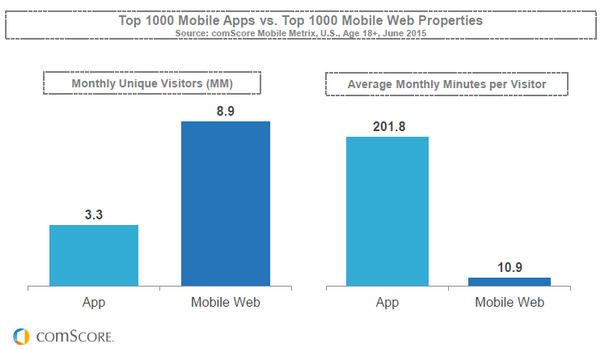
Mobile app users are more loyal to interacting with the brand. Source: comScore
The use of the mobile web or mobile app is completely depending on the situation and characteristics of your business. In some cases, a good mobile web is all you need to provide the best experience for your customers. In other cases the mobile app is a better choice. When faced with the question of whether you should invest in a mobile web or mobile app, here are some questions you should ask yourself:
– Are the features too complex to need developing a mobile app or can it be solved with the website?
– How does the mobile app’s ROI work if you invest in it? How it will be if you invest in a mobile web?
– Who are your customers? Do they prefer mobile web or mobile app?
– Is your mobile app what users use frequently and daily?
….
In some cases, if you want to reach more customers, you may need to have both a mobile web and a mobile app. Mobile web works as the mouth of the funnel catching new users and mobile app can be considered as the bottom of the funnel, helping you keep loyal customers.
New solutions are emerging
The definitions of mobile web and mobile app are increasingly blurred with the development and emergence of new solutions aimed at addressing the limitations of both mobile web and mobile app.
1.Progressive web app
The Progressive web app (PWA) is a new trend aiming to turn the web app into a new standard for mobile applications. At this point the user can completely skip installing an application just to access the content of that service. Users can access the mobile website of the service through the browser and then just add the service icon to the home screen, just like a bookmark. Next time users can open the service on the phone without having to enter the browser again.
Flipkart.com is one of the first PWA applications. Watch the clip below to understand what PWA is and how to experience Flipkart’s PWA test.
Note: In Vietnam, Lazada.vn also seems to have PWA. I am not so clear about other e-commerce services
2. Mobile app streaming
Just hearing the name can give you some clues, the mobile app streaming allows you to use an application directly and in real time without having to install it on your phone by “streaming” the app which is being located on the cloud server.
Currently there are no apps that use this new mobile app streaming technology, except for a demo from Google as you can see below:
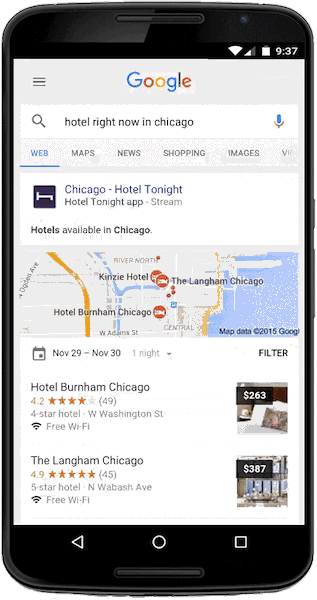
Source: google
3. Developing on the OTT platform
Why do you have to develop a whole new application and spend a lot of money to push it to the user while you can help your application be approached by millions of users available? OTT chat app such as Zalo currently has more than 45 million users, accounting for nearly all Internet population in Vietnam. Now if you can develop an application right inside Zalo, you can exploit Zalo to reach over 45 million users. Users do not need to download or install a new application because Zalo is an application that they already have in their phone.
Applying OTT as a new platform of application is an undeniable trend and will certainly be very popular in the future. Why you need to install the Uber app if you can call Uber right on Facebook Messenger:
These new solutions may not be immediately available, but may be the trend of the mobile in the next 1-2 years. Let’s see at what trend will be most selected by users. If you have any questions, please leave your comment below.



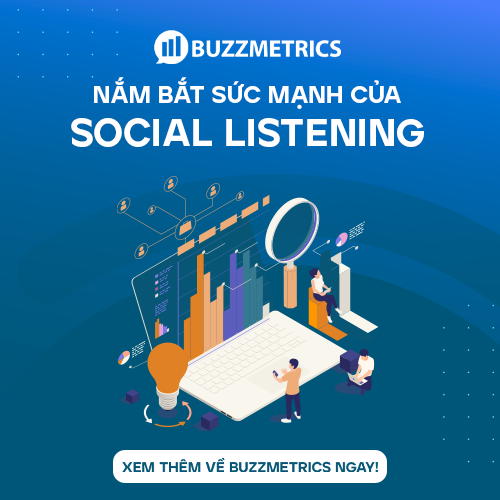
 Vietnamese
Vietnamese English
English